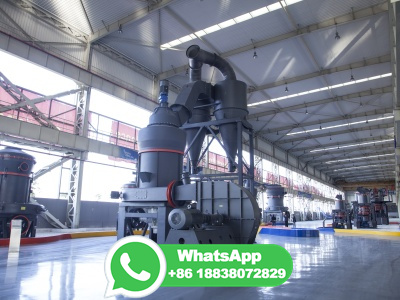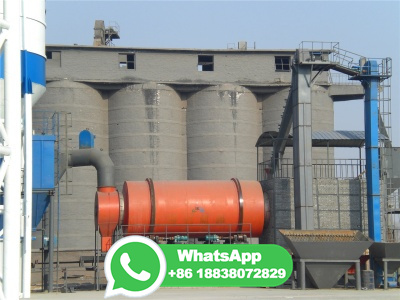
WEBMay 3, 2023 · The process of converting wood to coal is called carbonization. Advertisement Advertisement New questions in Science. compare the distance (number of parallel lines) from the mirror of the object with that of the image. I. Write True (T) or False (F) against the following statements in the given brackets: 1. The coldest planet in the .
WhatsApp: +86 18203695377
WEBJul 1, 2020 · Figure 1. Figure 1. Thermochemical/alytic approach for conversion of coal/biomassderived volatiles into chemicals or fuel additives. This review outlines the main progress performed in recent years on conversion of coal and biomass volatiles over the CFP process and gasifiion reforming.
WhatsApp: +86 18203695377
WEBJan 1, 2018 · The wood distillation process provided an extract that contained many impurities besides the methyl alcohol. The process was improved in the 1660s by scientist Sir Robert Boyle. ... The process of converting syngas into crude methanol occurs at a pressure of 50–100 ... The production process for obtaining methanol from coal and .
WhatsApp: +86 18203695377
WEBIn woodworking, hewing is the process of converting a log from its rounded natural form into lumber (timber) with more or less flat surfaces using primarily an axe. It is an ancient method, and before the advent of the industrialera type of sawmills, it was a standard way of squaring up wooden beams for timber framing.
WhatsApp: +86 18203695377
WEBCoalifiion is a geological process of formation of materials with increasing content of the element carbon from organic materials that occurs in a ... The aromaticity of coal and coalified wood is greater in bituminous coals than in subbituminous coals (Hatcher, 1988; ... the conversion of the lignin of the plants into humic substances, ...
WhatsApp: +86 18203695377
WEBThe process of conversion of wood into coal is called carbonisation. Page No 77: Question 4: _____ is the variety of coal with maximum carbon content. Answer: Anthracite is the variety of coal with maximum carbon content. Page No 77: Question 5: Petroleum and natural gas were formed dead _____
WhatsApp: +86 18203695377
WEBFeb 11, 2023 · The conversion of biomass to energy is known as biomass to bioenergy (B2B) conversion [84]. In India, biomass is one of the most commonly used energy sources, and is used both as a direct energy source and as a feedstock for energy production. It is estimated that about 80 % of the total rural energy demand in India is .
WhatsApp: +86 18203695377
WEBJun 1, 1992 · This difference could be explained by a different pyrolysis behaviour or by alytic effects of the min eral matter in peat and brown coal. In wood gasifiion carbon conversion is 12 1,8 I 1,6 1,4 8 II 0,8 0,6 0,4 E. Kurkela and P. St~hlberg/ Fuel Processing Technol. 31 (1992) 121 EQU~UBRIUM PEAT NO ~EAM PEAT STEAM .
WhatsApp: +86 18203695377
WEBJul 8, 2023 · The practice of burning wood for energy generation has seemed like an anachronism in the 21 st century to many, including, frankly, myself. After all, one of the main reasons why England shifted ...
WhatsApp: +86 18203695377
WEBText Solution. Verified by Experts. The correct Answer is. A. Carbonization is the term for the conversion of an organic substance into carbon or a carboncontaining residue through pyrolysis or destructive distillation. It is often used in organic chemistry with reference to the generation of coal gas and coal tar from raw coal.
WhatsApp: +86 18203695377
WEBThe process of conversion of wood into coal is called carbonisation. Page No 77: Question 4: _____ is the variety of coal with maximum carbon content. Answer: Anthracite is the variety of coal with maximum carbon content. Page No 77: Question 5: Petroleum and natural gas were formed dead _____
WhatsApp: +86 18203695377
WEBAug 1, 1999 · The raw materials (Swedish birch wood, Daw Mill coal of UK origin and Polish coal) used were milled and sieved. The particle size of the wood feed was 1–3 mm, and of the coal feeds 1– mm and – mm for Daw Mill coal and Polish coal, moisture content of the wood feed was wt.%, and of the Daw Mill .
WhatsApp: +86 18203695377
WEBThe process in which the wood of the forests was converted into coal under high temperature and pressure over millions of years is called. A. ... Verified by Toppr. Correct option is B. Carbonisation. Was this answer helpful? 0. Similar Questions. Q1. The slow conversion of wood into coal by a biochemical process extending over millions of ...
WhatsApp: +86 18203695377
WEBFeb 8, 2021 · Coal due to its relatively large quantities and wide distribution worldwide has generated renewed interest in research and development with the aim of establishing coal conversion technologies that are technically reliable, environmentally and economically feasible. It has proved to be a prominent energy source in emerging markets with .
WhatsApp: +86 18203695377
WEBOct 9, 2014 · The Process of conversion of wood into coal by biochemical process, taking over millions of years, is called _____ Science Sources of Energy
WhatsApp: +86 18203695377
WEBIn coalfired powerplants, the chemical energy in the coal, after a series of transformations, gets converted into electrical energy The sets of energy transformations inside a coalfired power plant are given in the points below. During the process of combustion, the chemical energy in the coal gets converted into thermal energy.
WhatsApp: +86 18203695377
WEBDec 1, 2013 · The carbon conversion rate was above 92% (from wood to CO, CO2 and CH4) and the hydrogen conversion rate was 67–76% (from wood to H2 and CH4). The LHV (lower heating value) of the producer gas ...
WhatsApp: +86 18203695377
WEBJan 5, 2023 · Coal to Make Coke and Steel. Metallurgical coal (also called "met" coal) is an important raw material used in the steelmaking process, although very small amounts of coal (relative to the amount used for electricity) are needed. The coal used to make steel is heated without air in an oven at temperatures of as much as 2,060°F (1,125°F ...
WhatsApp: +86 18203695377
WEBMay 16, 2019 · Waste conversion. Scientific studies have demonstrated that it is possible to generate a wide variety of bioenergy from biomass residues and waste, and however its cost is not competitive with petrofuels and other renewable energy. Ongoing efforts are continued extensively to improve conversion technologies in order to reduce production .
WhatsApp: +86 18203695377
WEBJun 1, 1992 · Similar conversions were also observed in brown coal and wood gasifiion, but since the nitrogen content of these fuels is lower, the ammonia concentrations were corre spondingly lower and ranged between and vol% for wood and between and vol% for brown coal. ... The conversion of wood nitrogen into ammonia .
WhatsApp: +86 18203695377
WEBJan 1, 2013 · Coal gasifiionbased processes for conversion of coal to liquid fuels and chemicals have been in commercial operation for considerably longer than gasifiion for power generation. Methods for the conversion of coal to liquid fuels (CtL) have been available since the 1930s, but widespread acceptance of the technologies has been .
WhatsApp: +86 18203695377
WEBApr 15, 2021 · A snapshot of the conversion process, from wood all the way to purified ethanol. Credit: Eric Sundstrom and Carolina Araujo Barcelos/Berkeley Lab
WhatsApp: +86 18203695377
WEB42 GJ (net calorific value) =. 10 034 Mcal. 1 tonne of coal equivalent (tce) =. GJ (net calorific value) =. 7 000 Mcal. Note: the tonne of oil equivalent currently employed by the International Energy Agency and the United Nations Statistics Division is defined as 10 7 kilocalories, net calorific value (equivalent to GJ)
WhatsApp: +86 18203695377
WEBOct 23, 2023 · The amount of hydrogen produced is consistent with the process of cogasifiion of woodbased biomass and coal using air and steam. This process is aimed at producing syngas that can be used to create liquid fuels from biomass and coal.(Kumabe et al. 2007). Effect of varied equivalence ratio
WhatsApp: +86 18203695377
WEBDestructive distillation is a chemical process in which decomposition of unprocessed material is achieved by heating it to a high temperature; the term generally applies to processing of organic material in the absence of air or in the presence of limited amounts of oxygen or other reagents, alysts, or solvents, such as steam or is an .
WhatsApp: +86 18203695377
WEBJun 30, 2023 · Biomass contains stored chemical energy from the sun that is produced by plants through photosynthesis. Biomass can be burned directly for heat or converted to liquid and gaseous fuels through various processes. Biomass was the largest source of total annual energy consumption until the mid1800s.
WhatsApp: +86 18203695377
WEBJan 25, 2023 · This process of conversion of wood into coal in the absence of the air is known as carbonisation. Thus, coal found at greater depth is rich in carbon and lacking in moisture content. Types of Coal. There are four main varieties of coal: peat, lignite, bituminous, and anthracite, all of which are formed through the carbonisation process. ...
WhatsApp: +86 18203695377
WEBDec 17, 2018 · The article deals with the historical transition from coal to oil and natural gas, commonly referred to as hydrocarbons. This transition occurred throughout the industrialized world between the 1940s and 1970s, yet the causes for the shift from coal to hydrocarbons are only marginally understood. Drawing from recent research on .
WhatsApp: +86 18203695377
WEBMar 1, 2019 · Cogasifiion of high ash coal and biomass should have synergy for improving the H 2 /CO ratio in the product gas which is required for liquid fuel synthesis [21], [44].However, cogasifiion processes need a proper setup for coal and regionspecific biomass [19].The appropriate size of the coal and biomass is required to perform .
WhatsApp: +86 18203695377
WEBCoal was formed by the decomposition of large land plants and trees buried under the earth millions of years ago. In the absence of air, wood was converted into coal due to high temperature and high pressure inside the earth.
WhatsApp: +86 18203695377
WEBCarbonization is the term for the conversion of an organic substance into carbon or a carboncontaining residue through pyrolysis or destructive distillation. It is often used in organic chemistry with reference to the generation of coal gas and coal tar from raw coal.
WhatsApp: +86 18203695377
WEBOct 19, 2023 · Coal is a black or brownishblack sedimentary rock that can be burned for fuel and used to generate electricity. It is composed mostly of carbon and hydrocarbons, which contain energy that can be released through combustion (burning). Coal is the largest source of energy for generating electricity in the world, and the most abundant fossil fuel ...
WhatsApp: +86 18203695377